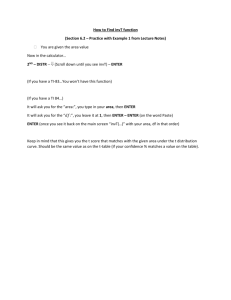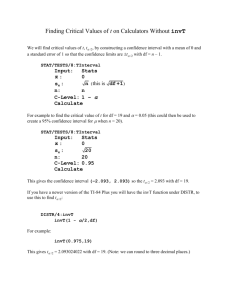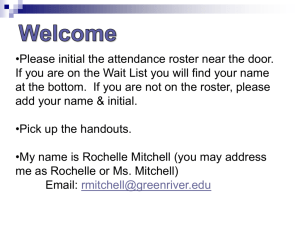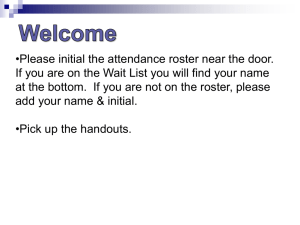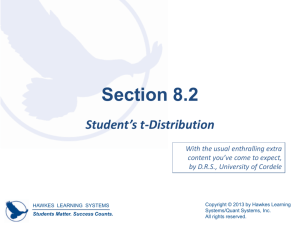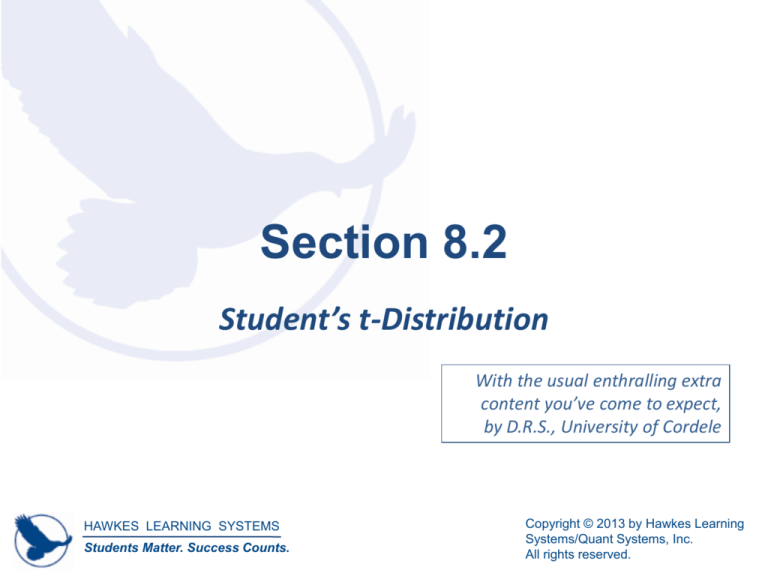
Section 8.2
Student’s t-Distribution
With the usual enthralling extra
content you’ve come to expect,
by D.R.S., University of Cordele
HAWKES LEARNING SYSTEMS
Students Matter. Success Counts.
Copyright © 2013 by Hawkes Learning
Systems/Quant Systems, Inc.
All rights reserved.
Student’s t-Distribution
1.
2.
3.
4.
Properties of a t-Distribution
A t-distribution curve is symmetric and bell-shaped,
centered about 0.
A t-distribution curve is completely defined by its
number of degrees of freedom, df.
The total area under a t-distribution curve equals 1.
The x-axis is a horizontal asymptote for a
t-distribution curve.
HAWKES LEARNING SYSTEMS
Students Matter. Success Counts.
Copyright © 2013 by Hawkes Learning
Systems/Quant Systems, Inc.
All rights reserved.
HAWKES LEARNING SYSTEMS
Continuous Random Variables
math courseware specialists
6.5 Finding t-Values Using the
Student t-Distribution
Comparison of the Normal and Student t-Distributions:
A t-distribution is
pretty much the
same as a normal
distribution!
HAWKES LEARNING SYSTEMS
Students Matter. Success Counts.
There’s this additional little
wrinkle of “d.f.”, “degrees of
freedom”. Slightly different
t distributions for different
d.f.; higher d.f. is closer &
closer to the normal
distribution.
Copyright © 2013 by Hawkes Learning
Systems/Quant Systems, Inc.
All rights reserved.
Observations about the t distribution
•
•
•
•
In the middle, at the mean, the t distribution peaks {
lower or higher } than the normal distribution..
In the tails, the t distribution is { lower or higher } than
the normal distribution.
The differences between the t and the normal
distributions are because there is more un__________ty
built into the t distribution.
As the sample size n gets larger,
the degrees of freedom d.f. gets larger,
the t distribution gets { closer to, farther from } the
normal distribution bell curve we use in z problems.
Why bother with t ?
• If you don’t know the population standard
deviation, σ, but you still want to use a sample to
find a confidence interval.
• t builds in a little more uncertainty based on the
lack of a trustworthy σ.
The plan:
1. This lesson – learn about t and areas and critical
values, much like we have done with z.
2. Next lesson – doing confidence intervals with t.
The t and the z tables – the same but different
z,
Standard
Normal
Distribution
Lookup z
in row
label and
column
header
Read inward to find the area.
The t and the z tables – the same but different
z,
Standard
Normal
Distribution
Lookup z
in row
label and
column
header
Read inward to find the area.
Choose which header row
and column for Area:
The
Choose the
t
df row =
Distribution sample size
n, minus 1.
area in 1 tail or in 2 tails
1 tail
0.100 0.050 0.025 0.010
df
2 tails 0.200 0.100 0.050 0.020
n–1
#.###
Read inward to find the t value.
The t and the z calculator functions
z,
Standard
Normal
Distribution
The
t
Distribution
If I know AREA and want to
work backward to find z
1) What z has area = .0500 to
its left?
2) What z has area .9500 to
its left?
If I know two z values and
I want the area between
them
What is the area between
z = -1.645 and z 1.645 ?
If I know AREA and want to
work backward to find t
Find the t and –t values such
If I know two t values and I
that the area in two tails is
want the area between
.1000 for df = 20.
Area in one tail is ________; them (Less common, use
tcdf(low t, high t, df)
Answer: t = _____ (positive)
if it comes up.)
Example 8.9: Finding the Value of tα
Find the value of t0.025 for the t-distribution with 25
degrees of freedom.
tα means “what t value has area α to its right?
(And because of symmetry,
α is also the area to the left of –tα)
For finding critical values
of t, using the table is the
quickest and easiest way
to find the needed value.
Answer:
t = ____________
HAWKES LEARNING SYSTEMS
Students Matter. Success Counts.
Even though the TI-84 has
an invT function, we’ll
emphasize the table
method for t problems.
Also - invT is not available
with the TI-83 family.
Copyright © 2013 by Hawkes Learning
Systems/Quant Systems, Inc.
All rights reserved.
Example 8.9: Finding the Value of tα (cont.)
*
Seeking
t0.025 …
USE THIS ONE
Area in One Tail
0.100
0.050
23
0.200
1.319
Area in Two Tails
0.100
0.050
0.020
1.714
2.069
2.500
0.010
2.807
24
1.318
1.711
2.064
2.492
2.797
25
1.316
1.708
2.060
2.485
2.787
26
1.315
1.706
2.056
2.479
2.779
27
1.314
1.703
2.052
2.473
2.771
28
1.313
1.701
2.048
2.467
2.763
df
TI-84 only – not available on TI-83:
invT(area to the left, degrees of freedom)
it’s at 2ND DISTR 4:invT(
HAWKES LEARNING SYSTEMS
Students Matter. Success Counts.
0.025
0.010
Note TWO
sets of
headings!
One Tail &
0.005 Two Tails
invT(area to the left, degrees of freedom)
invT(0.025,25) gives -2.059538532
then you have to fix up the sign & round
Copyright © 2013 by Hawkes Learning
Systems/Quant Systems, Inc.
All rights reserved.
Example 8.10: Finding the Value of t Given the
Area to the Right
Find the value of t for a t-distribution with 17 degrees
of freedom such that the area under the curve to the
right of t is 0.10.
Answer:
t = ____________
HAWKES LEARNING SYSTEMS
Students Matter. Success Counts.
Copyright © 2013 by Hawkes Learning
Systems/Quant Systems, Inc.
All rights reserved.
Example 8.10: Finding the Value of t Given the
Area to the Right (cont.)
*
Area in One Tail
0.100
0.050
0.025
0.010
0.005
df
0.200
Area in Two Tails
0.100
0.50
0.020
0.010
15
16
17
18
19
20
1.341
1.337
1.333
1.330
1.328
1.325
1.753
1.746
1.740
1.734
1.729
1.725
2.947
2.921
2.898
2.878
2.861
2.845
2.131
2.12
2.110
2.101
2.093
2.086
2.602
2.583
2.567
2.552
2.539
2.528
invT(area to the left, degrees of freedom)
invT(0.100,17) gives -1.33337939
then you have to fix up the sign & round
HAWKES LEARNING SYSTEMS
Students Matter. Success Counts.
Copyright © 2013 by Hawkes Learning
Systems/Quant Systems, Inc.
All rights reserved.
Example 8.11: Finding the Value of t Given the
Area to the Left
Find the value of t for a t-distribution with 11 degrees
of freedom such that the area under the curve to the
left of t is 0.05.
Answer:
(careful of sign!!!)
t = ____________
HAWKES LEARNING SYSTEMS
Students Matter. Success Counts.
Copyright © 2013 by Hawkes Learning
Systems/Quant Systems, Inc.
All rights reserved.
Example 8.11: Finding the Value of t Given the
Area to the Left (cont.)
*
Area in One Tail
0.100
0.050
0.025
0.010
0.005
df
0.200
Area in Two Tails
0.100
0.050
0.020
0.010
9
10
11
12
13
14
1.383
1.372
1.363
1.356
1.350
1.345
1.833
1.812
1.796
1.782
1.771
1.761
3.25
3.169
3.106
3.055
3.012
2.977
2.262
2.228
2.201
2.179
2.160
2.145
2.821
2.764
2.718
2.681
2.65
2.624
invT(area to the left, degrees of freedom)
invT(0.050,11) gives -1.795884781
then round (in this case, it is negative t)
HAWKES LEARNING SYSTEMS
Students Matter. Success Counts.
Copyright © 2013 by Hawkes Learning
Systems/Quant Systems, Inc.
All rights reserved.
Example 8.12: Finding the Value of t Given the
Area in Two Tails
Find the value of t for a t-distribution with 7 degrees of
freedom such that the area to the left of -t plus the
area to the right of t is 0.02, as shown in the picture.
Answer:
t = ____________
HAWKES LEARNING SYSTEMS
Students Matter. Success Counts.
Copyright © 2013 by Hawkes Learning
Systems/Quant Systems, Inc.
All rights reserved.
Example 8.12: Finding the Value of t Given the
Area in Two Tails (cont.)
If using the
table,
. just go
directly to 0.020
in the Two Tails
heading.
Area in One Tail
0.100
0.050
0.010
0.005
df
0.200
Area in Two Tails
0.100
0.050
0.020
0.010
5
6
7
8
9
10
1.476
1.440
1.415
1.397
1.383
1.372
2.015
1.943
1.895
1.860
1.833
1.812
4.032
3.707
3.499
3.355
3.250
3.169
But if using the TI-84 invT(), you must
divide 0.020 ÷ 2 = ______ area in one tail
first, and then….
HAWKES LEARNING SYSTEMS
Students Matter. Success Counts.
0.025
2.571
2.447
2.365
2.306
2.262
2.228
3.365
3.143
2.998
2.896
2.821
2.764
invT(area to the left, degrees of freedom)
invT(______,7) gives -2.997951566
then round and use the positive value
Copyright © 2013 by Hawkes Learning
Systems/Quant Systems, Inc.
All rights reserved.
Example 8.13: Finding the Value of t Given Area
between -t and t
Find the critical value of t for a t-distribution with 29
degrees of freedom such that the area between −t and
t is 99%.
This is a two-tail problem.
Area in middle = ______
Area in tails = ______
Answer:
t = ____________
HAWKES LEARNING SYSTEMS
Students Matter. Success Counts.
The area in two tails is _____
and the table has a two tails
heading.
If you’re using TI-84 invT
instead of the table, you’ll
need to divide by 2 and work
with the area in one tail.
Copyright © 2013 by Hawkes Learning
Systems/Quant Systems, Inc.
All rights reserved.
Example 8.13: Finding the Value of t Given Area
between -t and t (cont.)
@
Area in One Tail
0.100
0.050
0.025
0.010
0.005
df
0.200
Area in Two Tails
0.100
0.050
0.020
0.010
27
28
29
30
31
32
1.314
1.313
1.311
1.310
1.309
1.309
1.703
1.701
1.699
1.697
1.696
1.694
2.771
2.763
2.756
2.750
2.744
2.738
2.052
2.048
2.045
2.042
2.040
2.037
2.473
2.467
2.462
2.457
2.453
2.449
invT(area to the left, degrees of freedom)
invT(______,29) gives ______________
then round and use the positive value
HAWKES LEARNING SYSTEMS
Students Matter. Success Counts.
Copyright © 2013 by Hawkes Learning
Systems/Quant Systems, Inc.
All rights reserved.
Example 8.14: Finding the Critical t-Value for a
Confidence Interval
Find the critical t-value for a 95% confidence interval
using a t-distribution with 24 degrees of freedom.
Solution
This is a two-tail problem.
Area in middle = ______
Area in tails = ______
Answer:
t = ____________
The area in two tails is ____
and if using TI-84 invT,
you need to compute the
area in one tail which is ____
HAWKES LEARNING SYSTEMS
Students Matter. Success Counts.
Copyright © 2013 by Hawkes Learning
Systems/Quant Systems, Inc.
All rights reserved.
Example 8.14: Finding the Critical t-Value for a
Confidence Interval (cont.)
#
Area in One Tail
0.100
0.050
0.025
0.010
0.005
df
0.200
Area in Two Tails
0.100
0.050
0.020
0.010
21
22
23
24
25
26
1.323
1.321
1.319
1.318
1.316
1.315
1.721
1.717
1.714
1.711
1.708
1.706
2.831
2.819
2.807
2.797
2.787
2.779
2.080
2.074
2.069
2.064
2.060
2.056
2.518
2.508
2.500
2.492
2.485
2.479
invT(area to the left, degrees of freedom)
invT(______,____) gives _____________
then round and use the positive value
HAWKES LEARNING SYSTEMS
Students Matter. Success Counts.
Copyright © 2013 by Hawkes Learning
Systems/Quant Systems, Inc.
All rights reserved.
8.2 Practice and Certify Problems
• They come in pairs.
• You are given some area. You find the t value.
• The first part is easy – multiple choice from four
pictures: easy – left tail or right tail or two tails or
between two tails.
• The second part asks for the “critical value of t”,
what t value separates out the prescribed area.
• But the problem presentation is awkward and you
need to be prepared for it.
8.2 Practice and Certify Problems
• The second part asks for the “critical value of t”,
what t value separates out the prescribed area.
• The way it’s set up, you have to click in the table. It
doesn’t let you type in the box.
• There’s only one heading and it isn’t labeled. You
just have to know that it’s for area in one tail, so if
you have a 95% level of confidence, that means
there is area ________ in two tails,
so there is area ________ in one tail,
and that’s the heading you need for these problems.
8.2 Practice and Certify Problems
• The table the problem only has one header row and
the row isn’t labeled. It’s an “Area In One Tail”.
scroll bar to get
the proper df
Area in
One Tail
8.2 Practice and Certify Problems
• When you click in the table, the t value is copied to
the answer box.
• If you need to change it to a negative t value, click
the +/- button.
Also – “scroll bar” is
barra di scorrimento
in Italian.
Example 8.12: Finding the Value of t Given the
Area in Two Tails (cont.) – with Excel
• Recall: we seek t and –t such that
two tails total area 0.02, d.f. = 7
• Excel with convenient =T.INV.2T(total area, d.f.)
• Or Excel with one-tailed version, manually divide
area by 2: = T.INV(one tailed area, d.f.)
Example 8.11: Finding the Value of t Given the
Area to the Left , with Excel
• Excel: T.INV(area to the left of t, df), same thing.
• Excel special if you know area in two tails total:
=T.INV.2T(area in two tails total, df)

